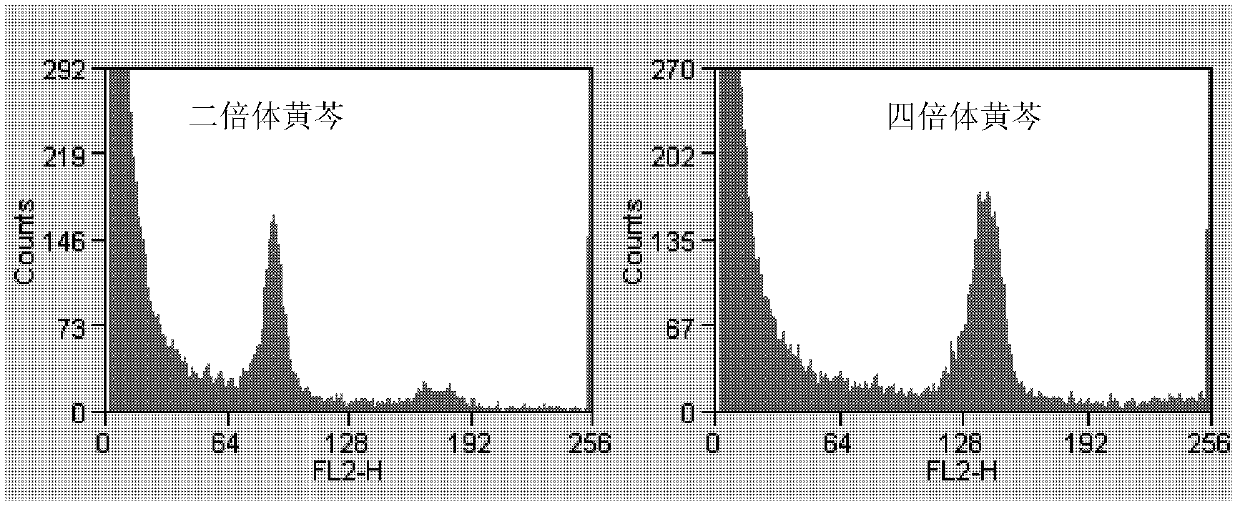Technical flow applicable to mass production of polyploidy radix scutellariae excellent variety
A polyploid, skullcap technology, applied in application, plant regeneration, horticulture, etc., can solve the problems of difficult seed production and high production costs, and achieve the effects of improving quality and yield, reducing production costs, and creating a huge body size.
- Summary
- Abstract
- Description
- Claims
- Application Information
AI Technical Summary
Problems solved by technology
Method used
Image
Examples
Embodiment 1 4
[0018] Induction of embodiment 1 tetraploid Scutellaria baicalensis
[0019] When the surface of the Scutellaria baicalensis callus differentiates into green buds, the callus is cut into small pieces with a diameter of 0.5 cm in an ultra-clean workbench, and the callus pieces are washed with 2% dimethyl sulfoxide (DMSO) Soak in 0.2% colchicine aqueous solution for 12-16 hours, rinse with sterile water for 3 times after treatment, inoculate into the culture medium for cultivation, make it differentiate into seedlings, the induction rate can reach 40.0%, the medium formula is as follows:
[0020] MS basic culture medium, sucrose 30g / L, agar 3.2g / L, 6-benzylaminopurine (6-BA) 0.5mg / L, chlormequat (PP 333 )0.5mg / L.
Embodiment 2 4
[0021] Example 2 Identification of tetraploid Scutellaria baicalensis-chromosomal microscopic examination
[0022] Each strain obtained by the treatment of Example 1 was induced to take root on the culture medium, and about 0.5 cm of the newly germinated test tube seedling root was cut, rinsed in distilled water, put into 0.1% colchicine solution at 20° C. for 30 min, and took out Afterwards, wash with distilled water for 3 times, put it into Carnot’s solution and fix it in the refrigerator for 2 hours, then wash with 95% ethanol, 70% ethanol, and distilled water successively for 3 times, isolate with 1M hydrochloric acid at 60°C for 5 minutes, and wash with distilled water for 3 times And hypotonic in distilled water for 30min. During microscopic examination, carefully cut out the root tip, put it in the center of the glass slide, add 1 drop of modified phenol-fuchsin staining solution, cover with a cover glass after 30 minutes, tap and press until the root tip is pressed int...
Embodiment 3 4
[0024] Example 3 Tetraploid Identification-Cell Flow Cytometry Analysis
[0025] Cut 1-2 leaves of Scutellaria baicalensis shoots, add 1ml of ice-cold buffer I to a petri dish, chop with a sharp blade, filter through a 40μm cell strainer, collect the filtrate, place it on ice, centrifuge at 500rpm for 5min, and stain the nuclei with PI staining solution. The DNA is fluorescently labeled, placed on ice, protected from light, and the plant ploidy is identified with a flow cytometer. After the sample is loaded, the flow cytometer automatically forms a DNA content distribution map representing the ploidy of the sample. The results of flow cytometry analysis of diploid Scutellaria baicalensis and tetraploid Scutellaria baicalensis cells are shown in the appendix figure 2
[0026] Buffer I: 45mmol / LMgCl 2 , 30mmol / L trisodium citrate, 20mmol / L MOPS, 0.1% TritonX-100, PH7.0.
[0027] PI staining solution: 50 μg / ml PI, 50 μg / ml RNase in buffer I.
PUM
 Login to View More
Login to View More Abstract
Description
Claims
Application Information
 Login to View More
Login to View More - R&D
- Intellectual Property
- Life Sciences
- Materials
- Tech Scout
- Unparalleled Data Quality
- Higher Quality Content
- 60% Fewer Hallucinations
Browse by: Latest US Patents, China's latest patents, Technical Efficacy Thesaurus, Application Domain, Technology Topic, Popular Technical Reports.
© 2025 PatSnap. All rights reserved.Legal|Privacy policy|Modern Slavery Act Transparency Statement|Sitemap|About US| Contact US: help@patsnap.com



